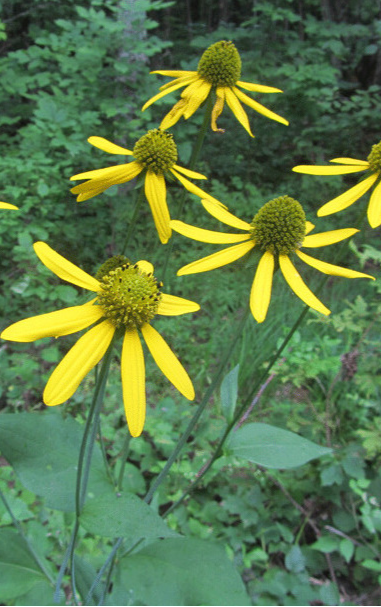- 2024 Native Trees
- >
- Herbaceous Plants
- >
- Cutleaf Coneflower (Rudbeckia laciniata)
Cutleaf Coneflower (Rudbeckia laciniata)
Height: 3 to 8 feet
Bloom Time: July to September
Bloom Description: Rays of yellow petals with green centers
Sun: Full sun
Attracts: Beneficial Insects, Pollinators, and Songbirds
Aster Family
Native to Jefferson County
Cutleaf Coneflower, also referred to as Green-Headed Coneflower, is an attractive summer bloomer. It has an upright branching growth habit, growing up to 8 feet high with a spread of 2 to 4 feet.
Cutleaf coneflower can naturally be found growing on wet to moist floodplains, fields and pastures, moist meadows, and along the edges of moist woods. It is tolerant of seasonal flooding, heat, and humidity. On the District’s Quaker Ridge property, Cutleaf Coneflower can be found throughout the floodplain of Cedar Lick Creek.
In natural landscape plantings, Cutleaf Coneflower is a showy addition to a wildlife garden or rain garden. Due to its lanky nature, it does best when in a mass planting or surrounded by other tall, robust plants for support. It also has a hardy root system that is good for stabilization and erosion control. Under ideal conditions, the gardener should be on guard—Cutleaf Coneflower has a tendency to aggressively colonize by way of its rhizomatic roots.
Cutleaf Coneflower is attractive to a large variety of insects, including honeybees, butterflies, moths, and other beneficial insects. It is a host plant for the Silvery checkerspot butterfly larvae and 22 other caterpillar species that forage on its leaves.
This plant also attracts songbirds foraging insects and later in the fall once the blooms have gone to seed. Songbirds known to visit Cutleaf Coneflower are goldfinches, wrens, vireos, wood warblers, and grosbeaks.
Deer, rabbits and other herbivores typically find the plant unpalatable and generally leave it alone. ■





